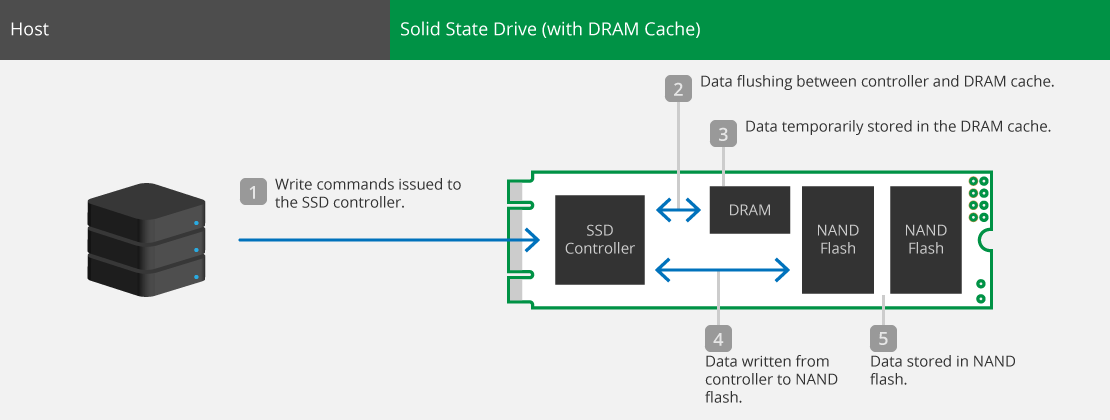Power Shield (PS)
How do Solid State Drives store data?
Data being written to SSDs is temporarily stored in DRAM cache memory before being transferred to NAND flash. This is done to take advantage of the quick response time of DRAM to boost the performance of the SSD. But as DRAM cache memory is volatile, an external power supply is required to hold and to flush data.
During a proper power shutdown process, notice is given by the host to the SSD controller that power will be immediately cut. The controller sends an acknowledgement back to the host and then flushes all data in the DRAM cache to the NAND flash.

However, during an unexpected power loss, the in-transit data can neither be stored nor flushed to the flash. In this case, data stored on the SSD is not updated, which can lead to a problem with data incompatibility, data corruption, or even total device failure.
Data at risk in a power failure
In the event of an unexpected power failure, data loss can take place in any of the following flows:

What is Power Shield (PS)?
Power Shield (PS) is a basic technology supported by all Transcend’s embedded SSDs to prevent internal NAND flash data loss in the event of a sudden power outage. The internal voltage detection circuit (VDT) of the controller monitors the external power supply. When external voltage drops from 5V to 4V or from 3.3V to 2.7V, the VDT activates the PS. When a sudden power outage occurs, the internal power shield circuit triggers the PS function so the controller will stop accepting new write commands. Write operation is halted to ensure that the firmware and data in the NAND flash remain undamaged.
Advantages of Transcend’s IPS & PS
Intelligent Power Shield (IPS) is another patented technology created by Transcend. For top performance, Transcend uses superior components, such as an advanced voltage detector, to trigger IPS. Additionally, Transcend utilizes polymer tantalum capacitors – heavy-duty, low-profile capacitors that operate stably in harsh environments. Though an entry-level feature that requires no added capacitors, PS similarly enables the SSD’s internal power detecting mechanism to monitor power provided by the host. When the power fails, the voltage drops, and the voltage detector triggers the PS, which makes the SSD controller stop writing data to the NAND flash. This ensures that the data stored on the NAND is intact. However, unlike IPS, PS doesn’t create extra buffer time for the NAND flash to complete the write process.
IPS
96 Capas
3D TLC
Hardware
With a built-in voltage detector (VDT) and inclusion of polymer tantalum capacitors (PTCs), IPS creates more time for data to be written from DRAM to NAND flash memory when voltage drops to between 4V and 2.3V.
When the external voltage drops to a certain level, the controller’s internal VDT activates the PS mechanism. The SSD controller then stops sending new write commands to the flash memory.
Firmware
Once IPS is triggered, the firmware automatically flushes data from the DRAM cache to NAND flash memory.
The SSD controller stops accepting new write commands from the host, ensuring the integrity of existing data on the NAND flash.
Summary
PS ensures data transfer integrity and minimizes the possibility of device failure during unexpected power outages on Transcend’s SSD products. To learn more about Intelligent Power Shield (IPS), please click here.
